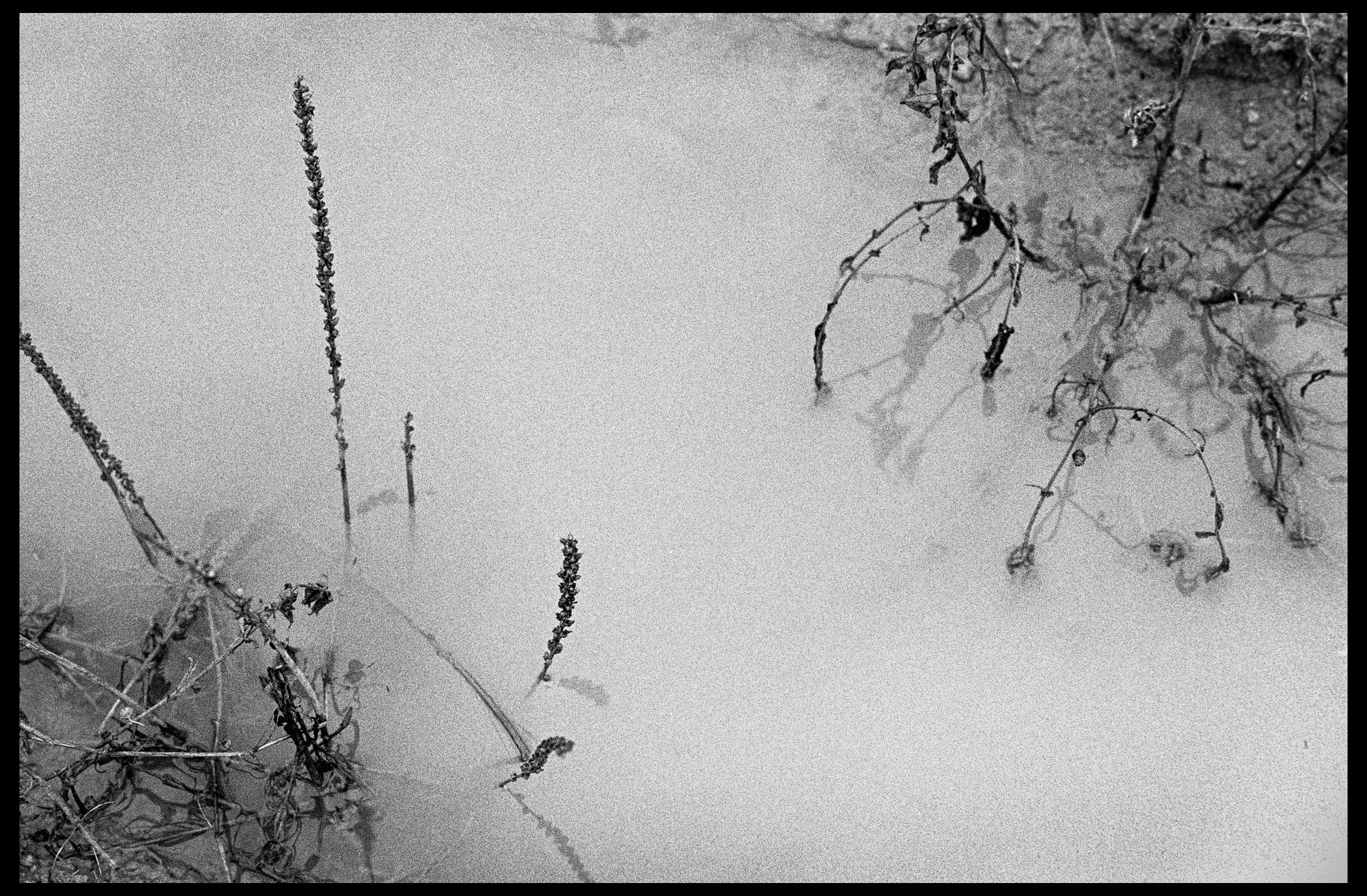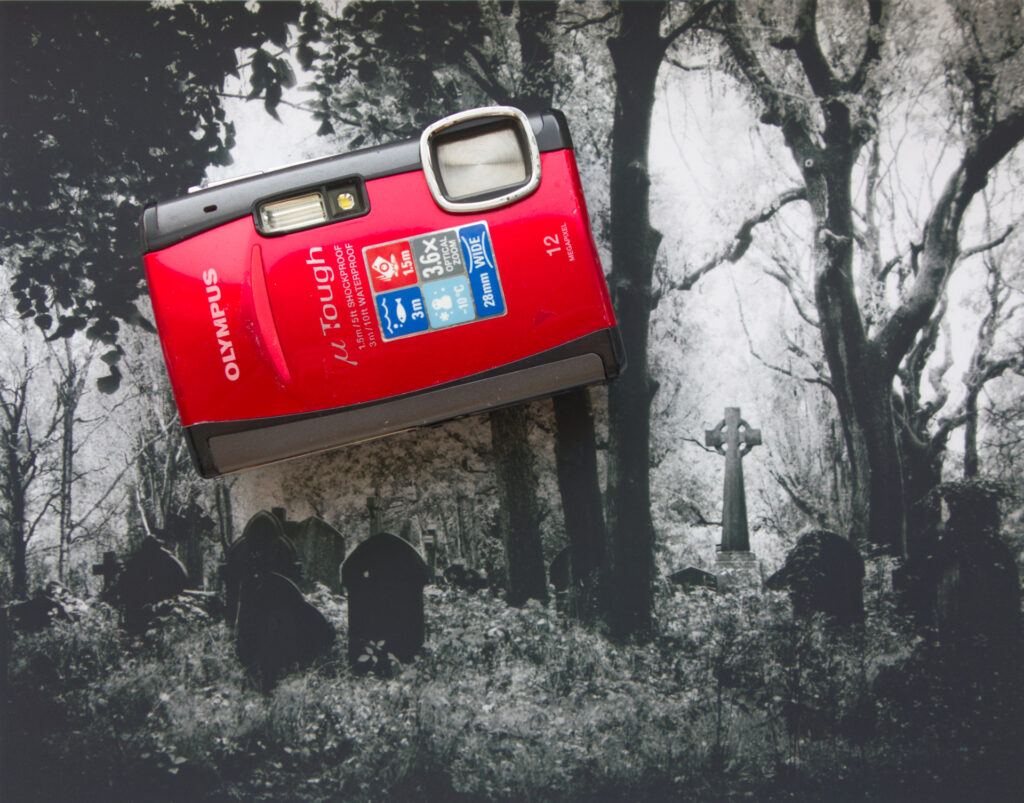I seem to have been taking photographs of the muddy puddles and flooded fields where I walk the dog for ever. She’s over 12 so I’ve seen a lot of seasons, a lot of rain, and a lot of mud and water. The landscape (under my feet) is always different even if the walk is largely the same. It all started in the digital realm (when Mollie the Springer was a puppy) and then morphed as I switched back to film six or seven years ago and then sort of stopped when I decided it had ran its course. I decided to shut the series down once I’d published a photobook, Earth. I was bored with it and had moved on to other projects. In fact I forced myself to stop taking any more photos because I wanted to devote mental energy and resources to other projects.
In those 12 years of the dog’s life (so far), I’ve had a number of jobs but have lived in the same place and taken the same (ish) walk pretty much every day. The walk has been quite a constant. Around that constant though, so much in me and my life has changed and evolved. Two changes over that period… retirement, and switching back to film, have been bigger than the others. And within the latter, GAS (of course). GAS always seems to reinvigorate projects! I bet you find that too.

But then I came back to the project with fresh eyes and fell in love with the subject all over again. And the new photographs were fresh too. They were simpler, more subtle, less complex and more meditative. Almost abstract. Or maybe I was looking at the subject with a more abstract eye. I had more time this time round. I was retired. I was out walking the dog at different times and at a different pace. I was more reflective too.

I became ever more fascinated with puddles and what lay just beneath their surface. And started noticing how ethereal and otherworldly the bottom of puddles looked, especially on film. Or rather as photographs. It reminded me of a Garry Winogrand quote. When asked why he took photographs he replied “I photograph to find out what something will look like photographed“. I do that.

When I saw the photographs of these puddles and their contents, I also loved how the photographs looked. I loved how the subject matter perfectly matched the medium – grainy film. The graininess made the images. The images needed the grain.

I choose to have grain. I use Rodinal to help feed my love of grain. Grain with Rodinal, pretty much irrespective of the film stock, is delicious, tight, defined and sumptuous. The subjects I choose to photograph tend to benefit from grain, like the puddles, I love expanses of shades of grey. Moriyama has been an influence with his cars, hats, wire fences, skies, clouds and so on. And his out of focus subjects. They all benefit from the grain.

And part of the success of these images, a small but important part, is about the sharpness of the neg scans. There’s no point having grainy images (or using beautiful lenses) if the scans are mushy. I’m a big fan of home neg digitisation and am obsessed with sharpness. Edge to edge sharpness specifically. I’m now on my third neg holding contraption, third digitisation camera, and fourth or fifth lens (not counting all the shoe box sized dedicated scanners I’ve tried). Not each change of kit/upgrade, however, has been driven by sharpness per se, but I’m now, with my latest acquisition very happy indeed with the effortless edge to edge sharpness. I won’t bore you with all the details because it’s actually all about the end result. But for those that want to know, my new favourite neg holder contraption is the JJC version of the Nikon ES-2 (it’s a direct copy/knock-off). Coupled to a staggeringly sharp macro lens like the Nikkor 60/2.8D, the results are breathtaking, as you can see here. And crucially, results as good as these are easy to achieve with no annoying alignment process needed (of any kind, at any point). Effortless.

These scans (this level of scanning in general) let the grain shine through, exactly as it should, and show off the photographs to their truly best advantage. I love that you can look around the image – all of it. Being able to zoom in and float around exploring minute details. Imagine you’re in a gallery looking at the image in a frame on the wall. You absorb the image as a whole. You can also approach as close as you like. So you do. You look at details. You look at things you hadn’t noticed. Contemplation. Reflection.

We all spend significant time and effort (technological and mental) in creating our images and I believe this needs to encompass creating the digitised image (unless of course, you’re darkroom only). I’m no longer a darkroom person but I am a huge believer in producing printed versions of my images and I’ve written about this before. A high quality digital rendition of my photographs is the hidden but key link in all of my printed work – from photobooks, to photopolymer etchings (photogravure), to articles like this one… it’s why I’ve spent so much time perfecting and upgrading my neg scanning capability – I don’t want it to be a weak link in my photography. That said, I also need this part of my process to be as simple, quick and straightforward as possible – it is, after all, a mundane part of my photography. To summarise, everything I do with my photographs requires scans of the highest possible quality, achieved in the simplest and most economical way. And, to be clear, I’m not claiming these are the best scans possible or are perfect, but they do suit my needs more than my previous efforts (by a long way).
All images Leica M3, Summicron 50/2 DR. Ilford HP5 in Rodinal 1:50. Digitised with a Nikon D810, Micro Nikkor 60/2.8D, the JJC ES-2 and Negative Lab Pro.
I’m on Insta and I have a website too.
Share this post:









Comments
Geoff Chaplin on The Surface of Water, Grain, and the Search for the Perfect Scan.
Comment posted: 26/05/2024
Comment posted: 26/05/2024
Comment posted: 26/05/2024
Comment posted: 26/05/2024
Philip Bovey on The Surface of Water, Grain, and the Search for the Perfect Scan.
Comment posted: 26/05/2024
Comment posted: 26/05/2024
Ibraar Hussain on The Surface of Water, Grain, and the Search for the Perfect Scan.
Comment posted: 26/05/2024
I find digital camera scans to be quite a bit harsher
Lovely photography and writing
Comment posted: 26/05/2024
Comment posted: 26/05/2024
Comment posted: 26/05/2024
Daniel Emerson on The Surface of Water, Grain, and the Search for the Perfect Scan.
Comment posted: 26/05/2024
Enjoyed the quirky, whimsical read. A different approach both subject wise and in the pursuit of projecting life from grey surfaces through your your management of grain. Talking of grain, if you had both time and inclination,I would be interested in seeing a.a highly enlarged section over an abrupt change in density to show grain patterns, so to to understand what you are achieving. This seems to be in the opposite direction to the work of Geoff Chaplain
Regards
Daniel
Dan Emerson.
Comment posted: 26/05/2024
Comment posted: 26/05/2024
Comment posted: 26/05/2024
Comment posted: 26/05/2024
Comment posted: 26/05/2024
Comment posted: 26/05/2024
Andrea Taurisano on The Surface of Water, Grain, and the Search for the Perfect Scan.
Comment posted: 26/05/2024
Comment posted: 26/05/2024
Gary Smith on The Surface of Water, Grain, and the Search for the Perfect Scan.
Comment posted: 26/05/2024
Great article Nik!
Comment posted: 26/05/2024
Jeffery Luhn on The Surface of Water, Grain, and the Search for the Perfect Scan.
Comment posted: 26/05/2024
Loved the writing and pix. Tackling a subject that only dogs and young boys enjoy, is unusual!!! I try very hard to avoid grain with large film formats and HC110, but when there are broad areas of mid-tones punctuated by sparse details, grain adds needed texture. Isn't Rodinal great for that! I have a point source enlarger to further accentuate grain. Split filter printing makes it even more pronounced. Great article!
Comment posted: 26/05/2024
Gary on The Surface of Water, Grain, and the Search for the Perfect Scan.
Comment posted: 26/05/2024
Comment posted: 26/05/2024
Tony Warren on The Surface of Water, Grain, and the Search for the Perfect Scan.
Comment posted: 27/05/2024
Thanks again for the great read.
Tony.
Comment posted: 27/05/2024
David Tan on The Surface of Water, Grain, and the Search for the Perfect Scan.
Comment posted: 27/05/2024
Graham Orbell on The Surface of Water, Grain, and the Search for the Perfect Scan.
Comment posted: 27/05/2024
I agree with you about using the JJC equipment for scanning. I’ve done some tests with it and it’s the way to go. But I’ve delayed setting it up because I needed to rebuild my e-bike and that took longer than I expected getting bits from China. But now that’s finished and seeing it’s winter and raining all over New Zealand I plan to get back to digitising with my JJC again. Being retired seems busier than working. Or maybe I take longer. Your grain is great. By the way talking of grain do you remember Cowboy Kate & Other Stories by Sam Haskins 1964? You might have been too young to read it.
Comment posted: 27/05/2024
Comment posted: 27/05/2024
Comment posted: 27/05/2024
Comment posted: 27/05/2024
Comment posted: 27/05/2024
Comment posted: 27/05/2024
David Hume on The Surface of Water, Grain, and the Search for the Perfect Scan.
Comment posted: 27/05/2024
Roger on The Surface of Water, Grain, and the Search for the Perfect Scan.
Comment posted: 27/05/2024
Comment posted: 27/05/2024
Comment posted: 27/05/2024
Comment posted: 27/05/2024
Comment posted: 27/05/2024
Alexander Seidler on The Surface of Water, Grain, and the Search for the Perfect Scan.
Comment posted: 28/05/2024
ps. did you try the Sigma Art 70/2,8 macro lens ?
Comment posted: 28/05/2024